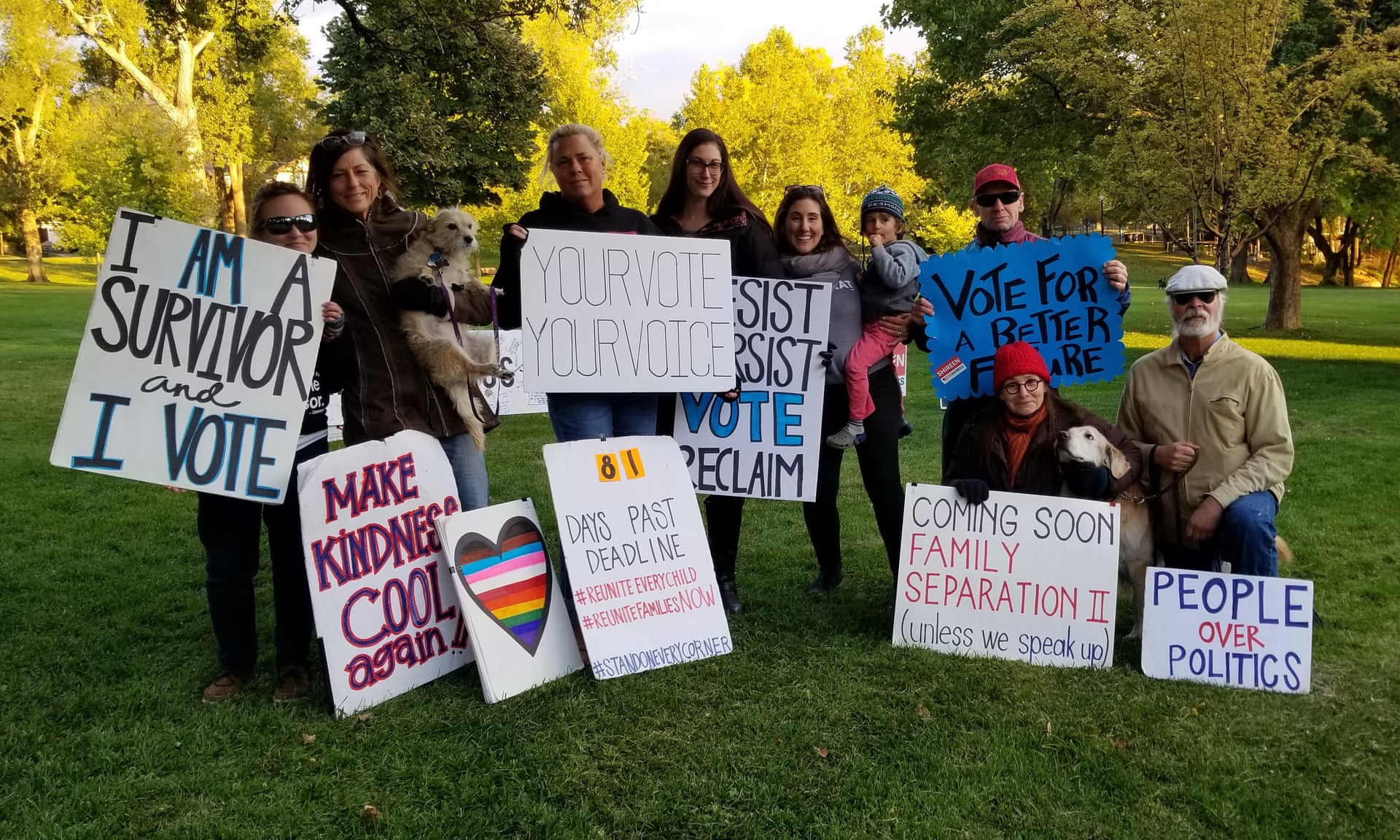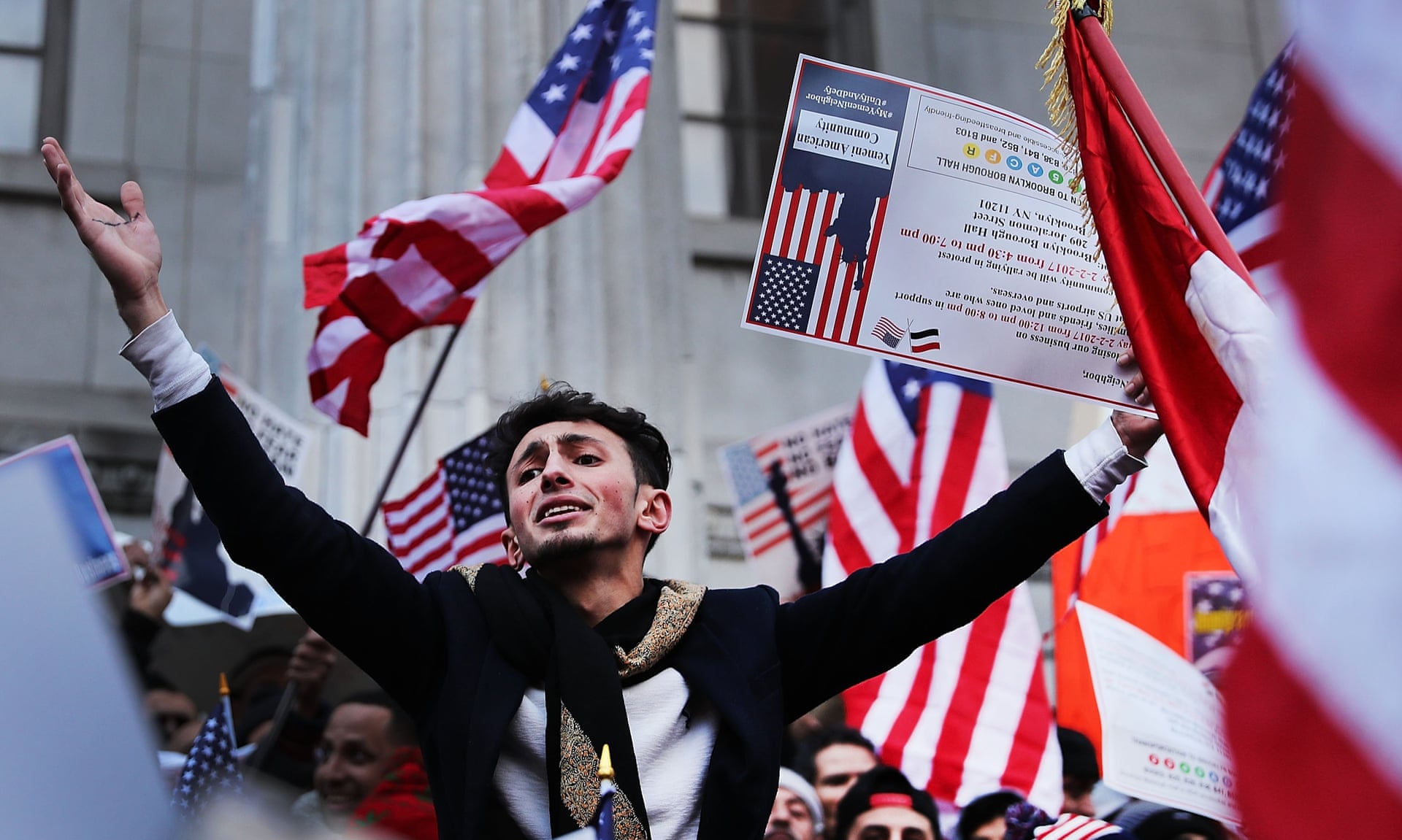
For 125 days last year, Ashley Weitz stood with her four-year-old son on a quiet corner near their home in Salt Lake City for one hour daily to protest Donald Trump.
This was unusual for a woman who had mostly ignored the wall-to-wall coverage of Trump’s unprecedented behavior in the White House, occupied instead by the full-time task of being a disabled, single mother. But when his administration separated thousands of migrant children from their parents at the border last summer as part of its immigration crackdown, Weitz erupted – a line had been crossed and she felt acutely the privilege in her life.
“I didn’t know how much I had been holding myself back,” Weitz told the Guardian. “We’re in this world of chaos right now and confusion and this onslaught of outrage and exhaustion and it’s all we can do sometimes to just survive this news cycle.”
Weitz became one of the millions of Americans to protest Donald Trump or the policies his administration has endorsed, joining the so-called “Resistance”.
“Something about easing into this thing, this protest, this rally, was easy in a way that a lot of things aren’t for me or for my family,” Weitz said.
A revitalized era of activism has bubbled up in the US in rejection of Trump and the values he has come to represent. The weekend marks two years since his inauguration, in which time millions of Americans have built on recent movements such as Black Lives Matter and the Fight for 15 campaign largely to rally, march and strike against the president.
In February 2018, one in five adults said they had attended a political protest, rally or speech in the previous two years, according to a poll by the Washington Post and Kaiser Family Foundation. Of that group, 50% said they had been more active than they were before.
People who said they had participated in activism were more likely to disapprove of Trump – 70% to 30%, according to the poll.
One day after Trump took office in January 2017, the Women’s March in Washington, DC, became one of the largest demonstrations in US history. It was soon followed by nationwide protests against his travel ban at airports, the March for Science and the Day Without Immigrants protests.
Political engagement reached a record high for the 2018 midterm elections, where voter turnout was the highest it had been in any midterm election in the past 100 years, with 50.3% of the voting-eligible population casting a ballot in November, according to the Election Project.
Before taking a stand on a corner, Weitz’s only previous experience protesting was when she joined the Salt Lake City Women’s March in 2017. Then last summer, she was upset about family separations when she spotted something on Twitter about the #StandOnEveryCorner campaign. These protests began in June 2018 and have since spread across the US as an easy way for people to “take a stand”.
Weitz, a survivor of child abuse and sexual assault, had felt numb when Trump was elected despite the publication of a video of him boasting that because he was famous he could “grab [women] by the pussy”.
The corner protest, however, gave her confidence to stand up with signs that read: “People over politics,” “Keep families together” and “#MeToo”.
Other protesters have joined Weitz and passersby regularly speak to her about political issues, in a mostly civilized manner, she says. Political candidates for local office stopped by to chat before the midterms and people have registered to vote at the corner. When conflict sometimes arises she has also learned to stand up for herself.
“This was an exercise in how I could trust my own voice on things,” Weitz said.
After the midterms, she scaled the protests back to once a week. She and other protesters now brave the cold with a propane heater and wool socks. “It’s just an hour and I wrap my son in 14 layers and he goes and makes snow angels and tries to get cars to honk and wave,” Weitz said.
Fighting for a community
While Weitz has taken over one corner in Salt Lake City, a city-wide movement has blossomed out of a corner shop strike in New York City.
In February 2017, hundreds of corner shops in the city, known as bodegas, shuttered for one day to protest Trump’s first travel ban, which prohibited people from seven Muslim-majority countries, including Yemen, from entering the US.
One of the people who helped organize the strike, Youssef Mubarez, said he was shocked by how many people participated.
“I saw people at this bodega strike protest who I had known since I was a child, who were quiet … I saw them on the shoulders of other Yemenis with megaphones, screaming and yelling,” Mubarez said. “It was amazing.”
This energy was soon channeled into the founding of the Yemeni American Merchants Association (Yama), a community action group where Yousse Mubarez now works as public relations manager.
“Shortly after the strike, it sort of woke us up,” Mubarez said.
The group is focused on strengthening the Yemeni business community, protecting Yemeni rights and educating Yemeni youth about how to become professionals in the US.
Though Mubarez was born in the US to parents who had immigrated a decade earlier, his extended family was caught up in the ban. He had protested before, joining demonstrations in New York City that impacted the Middle Eastern community, but Trump and the travel ban were something new.
Now, he travels to Washington, DC, for protests, trying to find people who can help them organize in a more formal way. “It’s figuring out who are the people in power … to make sure, starting from the bottom all the way to the top, that this never happens again,” he said.
A lifetime of activism
After 35 years of working in adult education and literacy, Joyce Hamilton’s relaxing first years of retirement fell to the wayside in June 2017.
The 68-year-old, who had for a long time campaigned on environmental issues, traveled with friends from her home in Harlingen, Texas, to the nearby border with Mexico to see migrant families waiting to seek asylum in the US.
The group was alarmed by the crowds that had formed outside official border checkpoints, where the government has been limiting how many people can seek asylum each day through a process known as “metering”. For months, metering has left droves of people, mostly families, stranded across the 2,000-mile border with Mexico, exposed to crime and bad weather while waiting to plead their case for humanitarian relief.
Hamilton and seven other women joined to form Angry Tías and Abuelas of the Rio Grande Valley, an informal group of mostly aunts and grandmothers assisting migrants with food, shelter and support.
The informal network of eight core members has since expanded to a community.
“At various points all of us has threatened to drop out of exhaustion and then realized we can’t, because once we get involved in this, you can’t just leave,” Hamilton said.
Originally published by The Guardian













